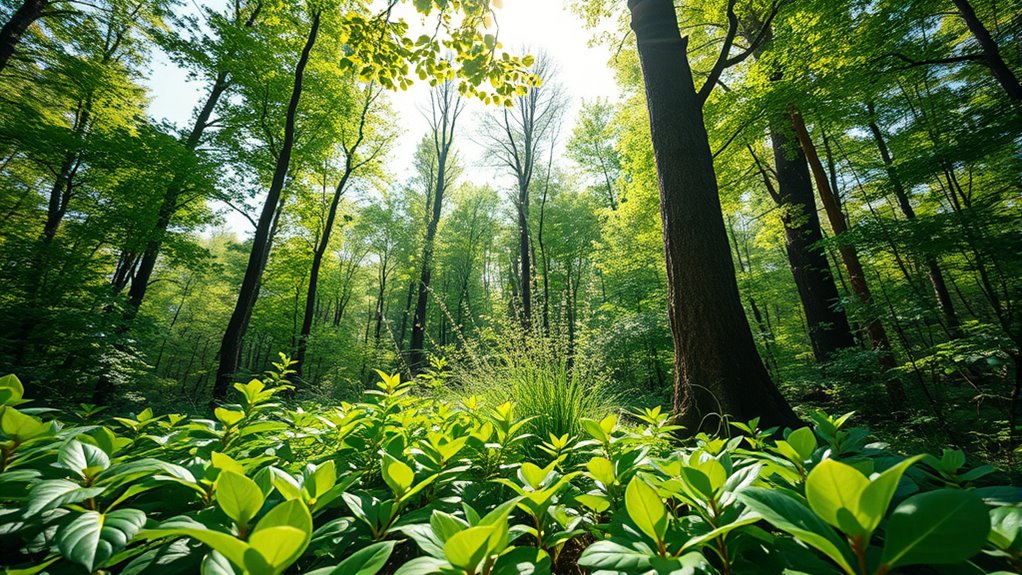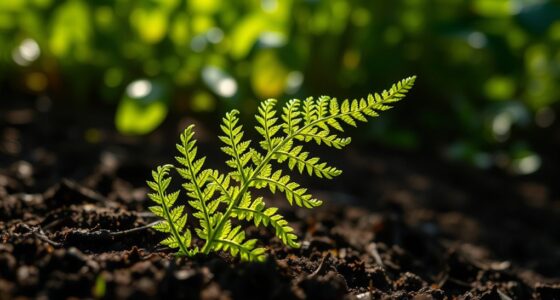Allelopathy is when plants release chemicals to suppress or inhibit their neighbors, giving themselves a competitive edge. For example, black walnut trees produce juglone, while eucalyptus trees release oils that hinder other plants. These natural chemicals can prevent weed growth and promote healthy soil, helping certain plants dominate their environment. Understanding these chemical fights reveals how plants communicate and compete, and if you keep exploring, you’ll discover even more fascinating ways nature manages plant interactions.
Key Takeaways
- Allelopathy involves plants releasing chemicals (allelochemicals) to inhibit or suppress neighboring plant growth.
- Black walnut trees produce juglone, a chemical that prevents many plants from growing nearby.
- Cover crops like rye release allelochemicals that naturally suppress weeds, reducing need for herbicides.
- Eucalyptus trees emit oils that create chemical zones hostile to understory plants.
- Soil microbes can degrade allelochemicals, influencing how plants chemically compete and coexist.

Allelopathy is a fascinating natural phenomenon where plants release chemicals to suppress or inhibit the growth of nearby competitors. It’s a survival strategy that helps plants reduce competition for resources like water, nutrients, and sunlight. When you observe a dense patch of plants thriving without much interference, you might not realize that some of them are actively working to keep rivals at bay through chemical warfare. These chemicals, called allelochemicals, are released into the soil through roots, leaves, or decaying plant material, and they can have powerful effects on neighboring plants. Interestingly, some of these chemicals can also influence soil microbes, further affecting plant interactions.
Plants release chemicals to suppress competitors and secure resources, shaping their communities through natural chemical warfare.
As you explore different plant species, you’ll notice that certain plants are more allelopathic than others. For example, black walnut trees produce juglone, a chemical that can inhibit many plants from growing nearby. This chemical diffuses into the soil, creating a zone where only specific plants can survive. Similarly, eucalyptus trees release oils that can suppress understory plants, helping them dominate the local environment. These natural chemical defenses give these plants an advantage, allowing them to monopolize resources and secure their survival in competitive ecosystems.
Understanding allelopathy also helps you grasp why some gardens or agricultural fields struggle with weed control. Certain cover crops, like rye or clover, release allelochemicals that can prevent weed seeds from germinating or stunting their growth. By planting these crops, you can naturally suppress unwanted plants without relying heavily on chemical herbicides. This approach not only promotes healthier soil but also reduces chemical runoff that can harm the environment. Additionally, research into water-based plant interactions reveals how water movement can influence the dispersion of allelochemicals, further shaping plant communities.
It’s important to recognize that allelopathy isn’t always purely beneficial for the plant producing the chemicals. Sometimes, these compounds can negatively affect the plant’s own roots or soil microbes, leading to complex interactions within the ecosystem. You might find that in natural settings, some allelochemicals degrade over time or are neutralized by soil microbes, allowing plants to coexist more harmoniously. This dynamic balance illustrates how plants have evolved sophisticated chemical strategies that shape their communities and influence biodiversity.
When you observe plant interactions in the wild or in your garden, keep in mind that allelopathy is a subtle yet powerful force at work. It shapes plant distribution, influences competition, and impacts the overall health of ecosystems. By understanding these chemical interactions, you gain insight into the intricate ways plants communicate and defend themselves, revealing a hidden layer of complexity in the natural world that’s both fascinating and essential for ecological balance.
Frequently Asked Questions
Can Allelopathy Be Used Intentionally in Organic Gardening?
Yes, you can intentionally use allelopathy in organic gardening. By selecting plants that naturally release chemicals to suppress weeds or pests, you create a healthier, more sustainable garden. For example, planting marigolds near tomatoes can deter nematodes, and rye cover crops release compounds that inhibit weed growth. Just make certain you understand each plant’s allelopathic effects to avoid harming desirable plants, and use them strategically for a thriving organic garden.
Are There Specific Plant Species Known for Strong Allelopathic Effects?
Did you know black walnut trees release toxins that inhibit over 100 plant species? Yes, some plants have especially strong allelopathic effects. Black walnut (Juglans nigra), for example, produces juglone, which suppresses many garden plants. Other examples include eucalyptus, which releases oils that deter competing plants, and sage, which can inhibit seed germination nearby. Recognizing these species helps you plan your garden to avoid unintended allelopathic conflicts.
How Do Environmental Conditions Influence Allelopathic Interactions?
Environmental conditions greatly influence allelopathic interactions. When soil is moist and warm, plants release more allelochemicals, intensifying their effects. Conversely, drought or cold can reduce chemical release, weakening allelopathy. Soil pH and microbial activity also affect chemical breakdown and absorption, either amplifying or diminishing these interactions. You’ll find that understanding these factors helps predict when allelopathy will be strongest or weakest in a given environment.
Can Allelopathy Cause Invasive Plant Species to Dominate?
Ever wondered if allelopathy helps invasive plants dominate? It definitely can. When invasive species release chemicals that suppress native plants, they gain a competitive edge. This chemical warfare allows them to spread quickly and establish dominance in new environments. So yes, allelopathy often plays a key role in invasive species thriving and outcompeting local flora, making it a vital factor in ecological shifts and biodiversity loss.
Are There Any Negative Effects of Allelopathy on Soil Health?
Yes, allelopathy can negatively impact soil health by releasing chemicals that inhibit beneficial microbes, reduce nutrient availability, and hinder plant growth. When these chemicals accumulate, they can lead to soil toxicity, disrupting the natural balance of microorganisms essential for maintaining healthy soil ecosystems. This, in turn, can make the soil less fertile and harder for other plants to thrive, creating long-term challenges for sustainable land use.
Conclusion
You can think of allelopathy like a plant’s secret weapon, quietly releasing chemicals to outcompete its neighbors. Imagine a sunflower, towering proudly, releasing compounds that suppress surrounding weeds—its way of saying, “This space is mine.” Just as a chess player strategically blocks opponents’ moves, plants use allelopathy to secure their survival. Understanding this silent battle reveals the intricate, chemical diplomacy happening in every garden, shaping the lush, complex ecosystems we often overlook.










